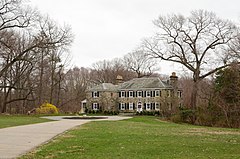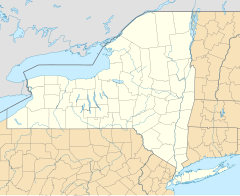Caumsett State Park
| Caumsett State Historic Park Preserve | |
|---|---|

Winter Cottage at Caumsett State Historic Park Preserve
|
|
| Type | State park |
| Location | 25 Lloyd Harbor Road Lloyd Harbor, New York |
| Coordinates | 40°55′39″N 73°28′18″W / 40.92750°N 73.47167°WCoordinates: 40°55′39″N 73°28′18″W / 40.92750°N 73.47167°W |
| Area | 1,520 acres (6.2 km2) |
| Created | 1961 |
| Operated by | New York State Office of Parks, Recreation and Historic Preservation |
| Visitors | 460,254 (in 2014) |
| Open | All year |
| Website | |
|
Marshall Field, III, Estate
|
|

Caumsett Hall in 2009
|
|
| Coordinates | 40°55′39″N 73°28′18″W / 40.92750°N 73.47167°W |
| Built | 1925 |
| Architect | Pope, John Russell; Holden, McLaughlin & Associates |
| Architectural style | English Revival |
| NRHP reference # | 79001633 |
| Added to NRHP | April 30, 1979 |
Caumsett State Historic Park Preserve
Caumsett State Historic Park Preserve is a state park on Lloyd Neck, a peninsula extending into the Long Island Sound, in the Village of Lloyd Harbor, New York. It is operated by the New York State Office of Parks, Recreation and Historic Preservation.
The 1,520-acre (6.2 km2) park covers the former Marshall Field III estate that was developed in the 1920s, and was listed on the National Register of Historic Places in 1979. Much of the park is today managed as a nature preserve, with a focus on protecting high-quality bird habitat.
Marshall Field III bought the property in 1921 and had an estate house built in 1925, one of the largest estates of the Gold Coast mansions. Field named the property "Caumsett", after the Matinecock tribe's original name for the peninsula meaning "place by a sharp rock".
The 1,426-acre (5.77 km2) Marshall Field III estate was purchased by New York State for $4 million on February 3, 1961 and became a state park. The former estate was listed on the National Register of Historic Places in 1979.
In May 1961, plans were made to create Caumsett State Parkway, a northern extension of Bethpage State Parkway, to provide access to the park. Although right-of-way was acquired, the parkway was never built. A portion of this land was later used to create Cold Spring Harbor State Park and Trail View State Park.
...
Wikipedia

